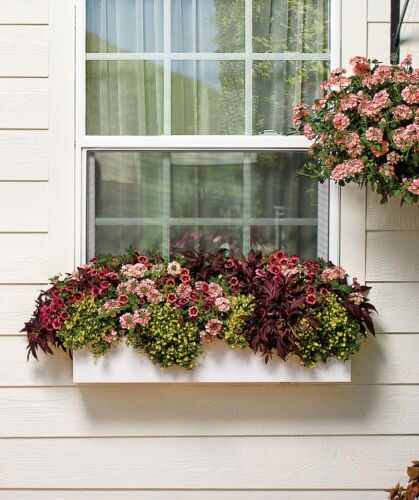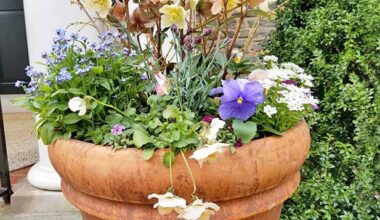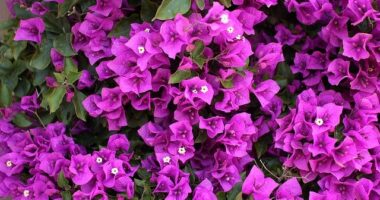Just because it is winter, and you may not be outside enjoying your balcony or small space does not mean that you have to give up gardening. You can create a winter window box as long as you know the correct plants to use.
We will take a closer look at 11 plants later in this post that we particularly like for window boxes.
We decided to give you a more extensive list of winter window box appropriate plants so you can kick your imagination and gear.
Contents
Best flowers for window boxes in partial sun:
- Arborvitae
- Asian star jasmine
- Blue fescue
- Blue oat grass
- blue spruce
- Boxwood
- Boxwoods
- Brazilian petunias
- Cold weather ornamental grasses
- Creeping raspberry
- Creeping thyme
- Dusty miller
- Dwarf Alberta spruce
- Dwarf Japanese sedge
- Evergreen ferns
- False cypress,
- Flowering cabbage
- Flowering kale
- Heathers
- Hens & chicks
- Heuchera plum pudding
- Holly
- Ivy
- Japanese yew
- Junipers
- Kale
- Leyland cypress
- Liriope
- Lowering heaths
- Miniature roses
- Monkey grass
- Ornamental cabbage
- Pachysandra
- Pansy
- Parsley
- Pines
- Purple fountain grass
- Rosemary
- Small mum’s
- Snapdragons
- Spruces,
- Sunroses
- Variegated ivy
- Viola
11 Best Plants for Window Boxes all year round
1. CORAL BELLS (HEUCHERA) ‘PURPLE FOREVER’
These plants are great for containers or window boxes because they produce clumps of rounded leaves. There are two kinds some have green leaves and very colorful flowers while others have hardly any flowers but their leaves are very striking such as the plum pudding varieties. They grow well in zones three through eight and can take full sun to what light shade.
2. ROSEMARY TREE
Rosemary that has been grown and cut into the shape of a small tree can be a wonderful focal point or end cap in an evergreen window box. It will survive winters in zone seven through 10, but in zones lower to seven it will need to be brought indoors. It is drug-resistant and a very hearty plant. It has wonderfully aromatic leaves.
3. CREEPING JUNIPER JUNIPERUS HORIZONTALIS AGNIESZKA
The creeping Juniper goes by several different names it is called the blue rug Juniper and also the blue mat Juniper. It grows to approximately 6 inches tall and spreads horizontally rather than vertically. This makes it ideal for year-round window boxes. The USDA recommends hardiness zones of three through nine for this plant. They thrive in full sunlight and fast draining soil.
4. CREEPING RASPBERRY RUBUS ROLFEI
This plan is used traditionally as a groundcover in gross 1 to 3 inches tall. The green leaves will form a dense carpet and does produce star-shaped weight flowers in the summer. As winter approaches, the leaves will change to a rust/pink color.
If you’re using the thrill fill and spill design theory of containers and window boxes this is a perfect ‘spill’ plant. Planted near the front of the box it will spill over the front with some wonderful trailing greenery. This groundcover is adaptable in that bulbs and other plants can grow through it.
5. AMERICAN ARBORVITAE ‘SMARAGD’
The ‘Smaragd’ is a semi-dwarf, compact, with a narrow pyramid shape evergreen. The American arborvitae in really non-technical terms is your basic evergreen. It comes in many variations and is the epitome of a harsh winter tree or shrub. They are generally needled evergreens that do not flower.
The ‘Smaragd’ is an extremely low maintenance plant that will grow in partial shade to full sun. It prefers well-drained soils but has a very wide range of solid soil tolerance. It needs good draining soil but is drought tolerant. Is typically used in a garden as a background or foundation plant and in hedges.
6. SEDUM RUPESTRE ‘ANGELINA’
This plant also goes by a common name of ‘stonecrop’. It is an evergreen that has needlelike foliage with yellow green tips to turn it reddish orange in fall. It grows to a height of 3 to 6 inches needs full sun but will handle light shade also. It is normally used as a groundcover but it works well in containers and window boxes. Arborvitae
7. ENGLISH IVY
Boston ivy, Virginia creeper, and English Ivy are all hard defines the tolerate cold weather very well. They are perfect for arbors, window boxes, and trellises. English Ivy is notorious for being a great climber. But, you can grow English Ivy in pots with a vertical steak or small trellis for some height. You can create a small topiary by training it to grow around the wire mesh. It can also simply droop over the front of the window box.
8. HENS & CHICKS SEMPERVIVUM
Sempervivum are commonly known as houseleeks and hens and chicks. They are succulent perennials and can serve as groundcover in your larger pots. They are adaptable to dry and sunny locations with fast draining sandy soil. Their low profile makes them very wind resistant. They grow as tufted rosettes. They are not necessarily held in high regard for their flowers but rather their geometric and architectural interest in design. These are great plants for window boxes or high-rise balcony gardens especially in terra-cotta or concrete planters or pots.
9. VIOLETS
Violas produce small and abundant flowers and are low growing perennials. They actually produce more flowers than pansies. They come in many varieties in different colors. Violas thrive in cool weather and like a lot of light, but not a lot of heat. Violas have 3 petals pointing down and 2 petals pointing up.
10. PANSIES
Pansies are actually a cross between two types of Violas, Viola lutea and Viola tricolor. They are renowned for the ability to grow just about anywhere. The major distinction between pansies and other violets is that the happy ‘face’ seen in the flower is much more distinctive and pronounced. Pansies have 1 downward pointing petal and 4 that point up.
11. BLUE FESCUE
This a plant that thrives living near the seaside. It grows in zones four through nine it has ever green foliage that is a spiky blue silver and is attractive all year round. The sunlight requirements are full sun to light shade.
BASIC AND SPECIAL CONSIDERATIONS FOR A WINTER WINDOW BOX
Window boxes are quite contemporary and very flexible in their design potential. You may hang them on deck rails, and on your fences besides keeping them on your window sills.
They can hold only a limited amount of soil, thus making it important that you create boxes with similar soil and watering needs.
Make sure that the window box you select will hold up to possible freezing and frost cycles. One handy trick that I would recommend to leave the plants in their own containers and just drop them into the window box. The entire window box becomes your cachepot.
If you look online you can actually find modular window boxes. But, it is simple enough to drop the pots directly into the window box and cover the top with moss, or good layer of mulch.
If you are setting up a window box for the first time, make sure there is room for air circulation around the box itself. Also, make sure that the water can drain from the window box away from your house to prevent water damage.
Another important consideration with having a window box is to make sure that it is secured extremely well to your banister, rail or fence. It is in an exposed location and will bear the brunt of strong winds. It is safest to go a bit overboard in securing your window box. Don’t cheap out here.
Some shrubs and perennials actually need the cold to send them into a dormant state so they can bloom or fruit the following season.
There can be some problematic issues with plants and severe, extended cold:
- frost damaging leaves and tender shoots
- hard freeze killing the entire plant
- freeze/thaw action of soil disturbing the roots or cracking the container
- weight of snow or ice breaking the plant
The above-mentioned points just how critical it is to select the proper plants for a winter window box.
Helpful Tip: Since window boxes are typically on balconies and in very exposed areas, select plants that can tolerate conditions one zone colder than where you actually live, for a safety measure.
WINTER WINDOW BOX DESIGN
Did you know that there is a formula for putting together plants in a container that will almost guarantee a visually appealing display?
Although I am a novice, weekend gardener, (trying to improve my skills). I stumbled across a formula that is used by experienced gardeners, florists and landscapers. It is as easy to remember as 1,2,3.
It is called the thrill, fill and spill.
- Thrill (height). This should be the tallest plant will go in the pot. It is placed to the rear. Ideally, this should be a real wowser, and eye-catcher and a show-stopper. It doesn’t necessarily have to be a flower. You can select your plant based on texture, color, or foliage.
- Fill (medium, filler plants). There is no mystery as to the function of a ‘fill’ plant. It is planted in front of the tall thrill plant and is used to cover the majority of the top of the urn. These plants should be short to medium in height so they are not competing with the thrill plant. Don’t be shy adding some color in this stage of the game. It will make your garden urn all that much more interesting. There are many, many plants that can be used as fills.
- Spill (cascading plants). Again, there should be no mystery about the function of the ‘spill’ plant. It should provide a gentle cascade right in the forefront of the urn. This is a good opportunity to use a vining plant if you like. The colors of your spill plant are entirely up to you. They may complement or contrast to your throw plants. They can also be neutral in color and provide more interest in their texture and droopy nature.
Thrill And Spill
Those rules work very well for container gardening and can work real well for window box design. However, often window box is far wider than it is deeper so the rules of placing plants forward and further back need to be adjusted slightly.
Because you have a very wide and relatively narrow container with a window box we need to think in terms of left or right more than in terms of front to back.
If you visualize a window box as having 3,4 or five ‘zones’ from left to right certain design ideas immediately start to become apparent.
Some design elements can be illustrated using the simple key of:
S = Short plants
M = Medium height plants
T = Tall Plants
SIMPLE CHRISTMAS WINDOW BOX DESIGN
I was looking through some YouTube videos to find some ideas about winter window box decoration and found this great two-minute video on creating a winter, Christmas-themed window box that takes about 10 minutes to put together.
It only uses two miniature cypress trees for live plants. The rest are decorations. I think this window box design is exceptional because of the height generated by the design and how full it looks even from the street.
HERE’S HOW TO DO IT:
- Start with window box with just soil and no plants.
- Anchor either end of it with a small, miniature cypress tree.
- Use long straight wire rods with a hook on one end. They are available at craft stores or you can make your own out of coat hangers.
- Insert it into the dirt in the middle of the window box.
- Also available at craft stores are greenery swags with a round eyelet on one end.
- Slide this eyelet swags onto the hooked wire rod which will hold the swags and upright position.
- Add a bow in the middle, tied to the rod. Then you can add some Christmas ornaments and pine cones and arrange them the way you like it.
CONCLUSION
We hope you enjoyed our post, ’11 Low Maintenance Winter Window Box Plants’. We gave you a huge list of 44 plants that are candidates for winter window boxes and then took a close look at 11 of them.
Wishing you the best in your gardening adventures.









